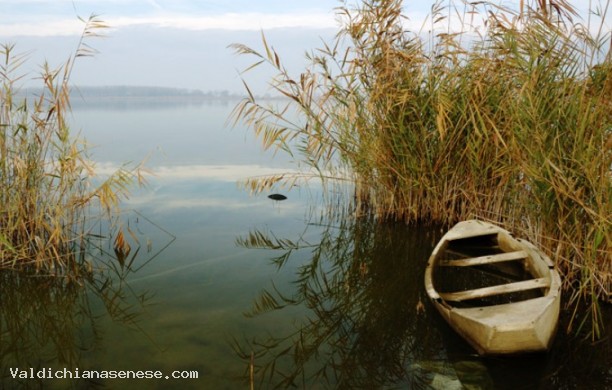> Home > What to visit > Place

Lago di Montepulciano - Oasi protetta della LIPU Montepulciano
PLACE

PHONE NUMBERS AND TIMES
Lago di Montepulciano - Oasi protetta della LIPU
Business card (vCard)
The lake is nowadays the heart of a natural reserve situated a few kilometers east of Montepulciano, in the western part of the Valdichiana, close to the boundary with Umbria. Besides the water surface, the reserve includes part of the Main Channel of the Chiana and some of the adjacent agricultural land. Both Lake Montepulciano and the nearby Lake Chiusi , interconnected, are the remainders of the vast swamp area, that had occupied great part of the Val di Chiana up to the Medici family’s times. Nowadays, it represents one of the most important wetlands in Central Italy . As a matter of fact, the Natural Reserve, is located along the migratory route that crosses Tuscany, from the Arno Valley to the Tiber Valley; therefore, it represents an important rest point for the avifauna that migrates seasonally from African countries to Europe. It’s also used by several bird species for wintering and nesting. The marshy reed cane thicket creates the predominant vegetation in the Reserve. The water vegetation is also quite varied. It includes many species ,that aren’t present anymore in the Italian wetlands, due to drainage and pollution. Among these species, the water lily, the cow lily, the water fringe, the Chiana water cress, the bladder wort, and two types of water fern, as the rare salviniya floating fern and the mosquito fern can still be found in this area. The humid meadows that edge, in some spots, the cane thicket, also host a rare marshy orchid and the adder’s tongue fern, rare type of fern itself. The nesting species in the area include the bittern, a type of heron , particularly rare in Europe, due to the gradual disappearance of the wetlands : Italy numbers only from twenty to thirty couples. The bittern builds its nest inside the cane thicket as does the little bittern and the purple heron. Other herons, as the white heron, black crowned night herons and squacco herons, nesting in the nearby Lake Chiusi, frequent daily the Reserve in search of food. Without any doubt, autumn and winter are the periods of the year when the lake is most populated with a great number of individuals. As a matter of fact, a great number of water birds ,mainly coming from northern Europe arrive in the lake, to pass the winter and then, in springtime, they return to their original place to nest .Particularly important, in the Reserve, is the presence of the ferruginous duck, a diving duck , globally considered an endangered species and very rare in whole of Italy. Other important species are the gadwall, that passes the winter in the Reserve with a good number of specimen; and the marsh hawk , that is present both during the winter and the spring-summer period. Among the species that inhabit Lake Montepulciano throughout the year, there are some that are quite particular, as the great crested grebe, elegant bird, present in the Reserve with fifty nesting couples. The lake is also inhabited by the king fisher, the water hen, the water rail and the moor hen, aside from a considerable number of passerines, linked to the cane thicket as the bearded reedling, the monstached warbler, the great reed warbler and the Eurasian river warbler.
STAY NEARBY
PODERE RAFFAELLO
MONTEPULCIANO
Immersi nel cuore della val di chiana, il podere Raffaello , antico casolare del 1700 &eg...Agriturismo CONTEA DI PIANDIVASCO
MONTEPULCIANO
L’agriturismo "Contea di Piandivasco" è ubicato in Toscana nel Comu...TIZIANA
MONTEPULCIANO
L’hotel-ristorante-bar, completamente ristrutturato dal maggio 2005, a gestione fami...DINING & ENTERTAINMENT NEARBY
Teatro del Concordi
MONTEPULCIANO
Il Teatro della Società dei Concordi è si trova nella frazione di Acquaviva ...Clev Village Multisala
CHIUSI
...Teatro Mascagni
CHIUSI
A dare i natali al teatro di Chiusi è l'Accademia dei Filateti, fondata nel 1818 e ...






